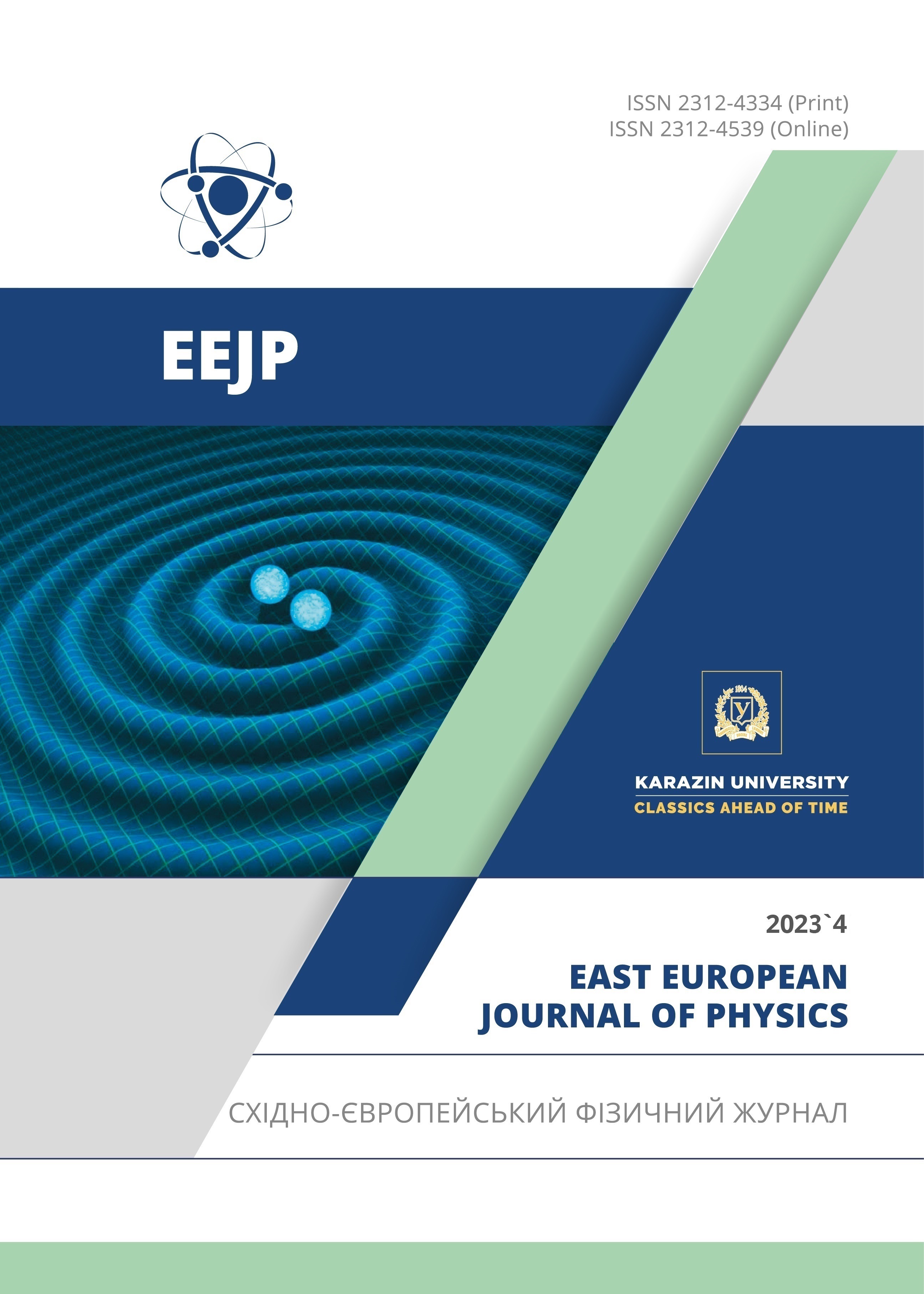Вплив температурно-залежних теплопровідності та в'язкості на ковзаючий потік нанорідини Максвелла
Анотація
Запропоновано математичну модель для перевірки впливу мінливих теплофізичних властивостей, таких як теплопровідність, ефекти ковзання та в’язкість, на нанорідину Максвелла. Теплопровідність швидко зростає через наявність у базовій рідині наночастинок, таких як метали, карбіди, оксиди тощо. Потік відбувається від застійної точки проходження розтягнутого листа з умовами ковзання. Також враховуються особливості броунівського руху, а також процеси термофорезу. За допомогою перетворень подібності ODE виводяться з рівнянь, що впливають на потік рідини. Вбудований розв’язувач MATLAB, а саме bvp4c, який є формулою спільного розташування, що реалізує чисельний метод кінцевих різниць LobattoIIIa, застосовується для чисельного розв’язання цих перетворених рівнянь. Проаналізовано графіки чисельних результатів, що представляють вплив варіацій різних параметрів на рух рідини, передачу тепла разом з масою. Це дослідження призводить до важливого аспекту, що, оскільки теплопровідність у потоці посилюється, температура рідини знижується з високою агрегацією наночастинок біля поверхні листа. Крім того, швидкість тепло- та масообміну зменшується через релаксацію рідини Максвелла. Крім того, ефективність представлених чисельних розрахунків визначається шляхом проведення порівнянь швидкостей тепло- та масопередачі з попередніми аналітичними результатами для кількох значень термофорезу та параметрів Прандтля. Ефективність його результатів може бути застосована в нанонаукових технологіях і полімерних галузях для їх розробок.
Завантаження
Посилання
S.D. Poisson, “Sur les Equations Generale de l’Equilibre et du Mouvement des Corps Solides Elastiques et des Fluides,” Journal de l’Ecole Polytechnique, 13(20), 18 17 (1829).
J.C. Maxwell, “On double refraction in a viscous fluid in motion,” Proc. R. Soc. Long. 22(148-155),46-47 (1873). https://doi.org/10.1098/rspl.1873.0011
L. Boltzmann, “Zur Theorie der elastischen Nachwirkung sitzungber,”Kaiserl-Akad, Wise. (Wien), Math. Naturwisslasse 70, (II), 1 22, 18 17, 30, 275-306 (1874).
H.A. Barnes, J.F. Hutton, and K. Walters, An Introduction to Rheology, (Elsevier, New York, 1989).
R.J. Poole, Rheology Bulletin, 53(2), 32 (2012). https://pcwww.liv.ac.uk/~robpoole/PAPERS/POOLE_45.pdf
K. Sadeghy, H. Hajibeygi, and S.M. Taghavi, International Journal of Non-Linear Mechanics, 41, 1242 (2006). https://doi.org/10.1016/j.ijnonlinmec.2006.08.005
S. Wang, and W. Tan, Int. J. of Heat and Fluid Flow, 32, 88 (2011). https://doi.org/10.1016/j.ijheatfluidflow.2010.10.005
K. Hiemenz, Dingler’s Polytech. J. 326, 321-324 (1911).
T.C. Chiam, International Communications in Heat and Mass Transfer, 23(2), 239-48 (1996). https://doi.org/10.1016/0735-1933(96)00009-7
T.C. Chiam, Acta Mechanica, 129, 63 (1998). https://doi.org/10.1007/BF01379650
J. Ahmed, M. Khan, and L. Ahmad, Journal of Molecular Liquids, 287, 110853 (2019). https://doi.org/10.1016/j.molliq.2019.04.130
M. Sunder Ram, K. Spandana, Md. Shamshuddin, and S.O. Salawu, Int. J. of Modelling and Simulation, 43(5), 670 (2022). https://doi.org/10.1080/02286203.2022.2112008
N.N. Reddy, D.R. Yanala, B.S. Goud, and S.R. Vempati, Heat Transfer, 52, 3538 (2023). https://doi.org/10.1002/htj.22839
H. Dessie, Heat Transfer. 50, 6984 (2021). https://doi.org/10.1002/htj.22213
Y.D. Reddy, and I. Mangamma, Numerical Heat Transfer, Part A: Applications, 1-27, (2023).https://doi.org/10.1080/10407782.2023.2230356
S. Choi, “Enhancing thermal conductivity of fluids with nanoparticles,” in: Developments and Applications of Non-Newtonian Flows, edited by D.A. Siginer, and H.P. Wang, (ASME, New York, 1995), pp. 99-105.
J. Buongiorno, Journal of Heat Transfer, 128, 240 (2006). https://doi.org/10.1115/1.2150834
A.V. Kuznetsov, and D.A. Nield, Int. J. Therm. Sci. 49, 243 (2010). https://doi.org/10.1016/j.ijthermalsci.2009.07.015
W.A. Khan, and I. Pop, Int. J. Heat Mass Transf. 53, 2477 (2010). https://doi.org/10.1016/j.ijheatmasstransfer.2010.01.032
O.D. Makinde, and A. Aziz, Int. J. of Thermal Sciences, 50, 1326 (2011). https://doi.org/10.1016/j.ijthermalsci.2011.02.019
M. Sajid, B. Ahmed, and Z. Abbas, J. Egyptian Math. Soc. 23, 440 (2014). https://doi.org/10.1016/j.joems.2014.05.013
Y. Abdela, B. Shankar, and T. Srinivasulu, Int. J. Comput. Eng. Res. 8(2), 2250 (2018). https://api.semanticscholar.org/CorpusID:208625190
G.K. Ramesh, B.J. Gireesha, T. Hayat, and A. Alsaedi, Alexandria Engineering Journal, 55, 857 (2016). https://doi.org/10.1016/j.aej.2016.02.007
R. Mishra, Int. J. Eng. Sci. Res. Technol. 6(4), 131 (2017). https://doi.org/10.5281/zenodo.557138
M.A. El-Aziz, and A.A. Afify, Math. Probl. Eng. (2018). https://doi.org/10.1155/2018/9402836
W. Ibrahim, and M. Negera, Journal of the Egyptian Mathematical Society, 28, 7 (2020). https://doi.org/10.1186/s42787-019-0057-2
O.D. Makinde, W.A. Khan, and J.R. Culham, Int. J. Heat Mass Transf. 93, 595 (2016). https://doi.org/10.1016/j.ijheatmasstransfer.2015.10.050
O.D. Makinde, F. Mabood, W.A. Khan, and M.S. Tshehla, Journal of Molecular Liquids, 219, 624 (2016). https://doi.org/10.1016/j.molliq.2016.03.078
A.O. Ali, and O.D. Makinde, Journal of Appl. Fluid Mech. 8(4), 793 (2015). https://doi.org/10.18869/acadpub.jafm.67.223.22967
S. Manjunatha, and B.J. Gireesha, Ain Shams Eng. J. 7, 505 (2016). https://doi.org/10.1016/j.asej.2015.01.006
D. Borgohain, Trends in Sciences, 19(21), 6306 (2022). https://doi.org/10.48048/tis.2022.6306
D. Iranian, K. Sudarmozhi, I. Khan, and A. Mohamed, International Journal of Thermofluids, 20, (2023). https://doi.org/10.1016/j.ijft.2023.100396
L.F. Shampine, M.W. Reichelt, and J. Kierzenka, Solving Boundary Value Problems for Ordinary Differential Equations in MATLAB with bvp4c. MATLAB File Exchange, (2004).
Авторське право (c) 2023 Дебозані Боргохайн

Цю роботу ліцензовано за Міжнародня ліцензія Creative Commons Attribution 4.0.
Автори, які публікуються у цьому журналі, погоджуються з наступними умовами:
- Автори залишають за собою право на авторство своєї роботи та передають журналу право першої публікації цієї роботи на умовах ліцензії Creative Commons Attribution License, котра дозволяє іншим особам вільно розповсюджувати опубліковану роботу з обов'язковим посиланням на авторів оригінальної роботи та першу публікацію роботи у цьому журналі.
- Автори мають право укладати самостійні додаткові угоди щодо неексклюзивного розповсюдження роботи у тому вигляді, в якому вона була опублікована цим журналом (наприклад, розміщувати роботу в електронному сховищі установи або публікувати у складі монографії), за умови збереження посилання на першу публікацію роботи у цьому журналі.
- Політика журналу дозволяє і заохочує розміщення авторами в мережі Інтернет (наприклад, у сховищах установ або на особистих веб-сайтах) рукопису роботи, як до подання цього рукопису до редакції, так і під час його редакційного опрацювання, оскільки це сприяє виникненню продуктивної наукової дискусії та позитивно позначається на оперативності та динаміці цитування опублікованої роботи (див. The Effect of Open Access).








